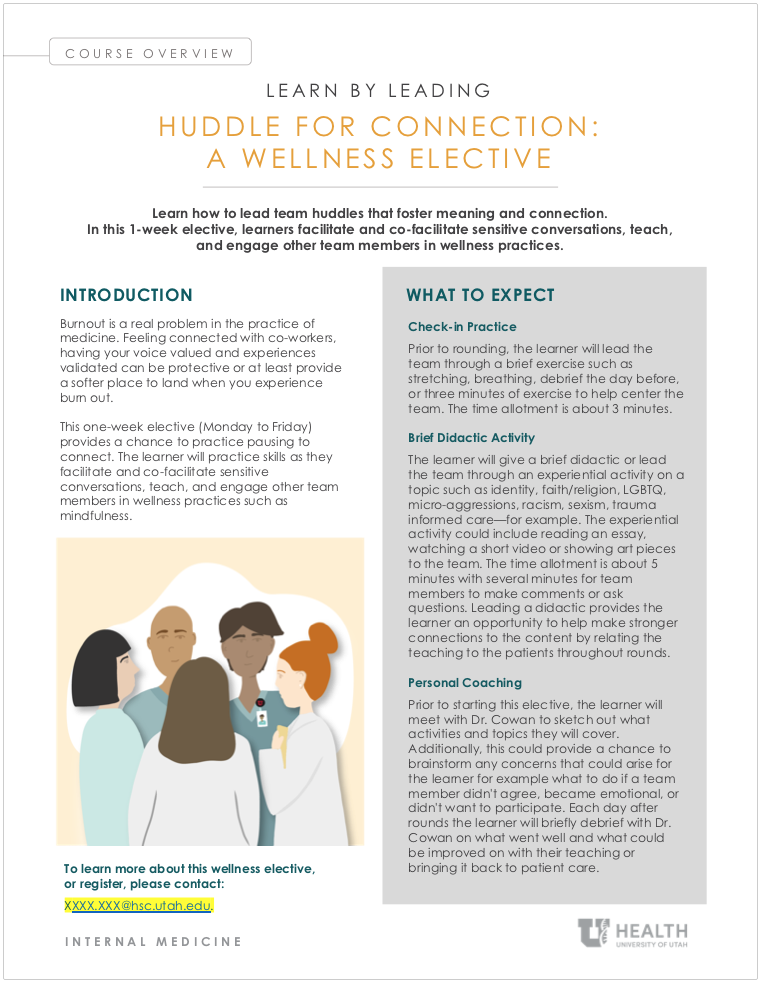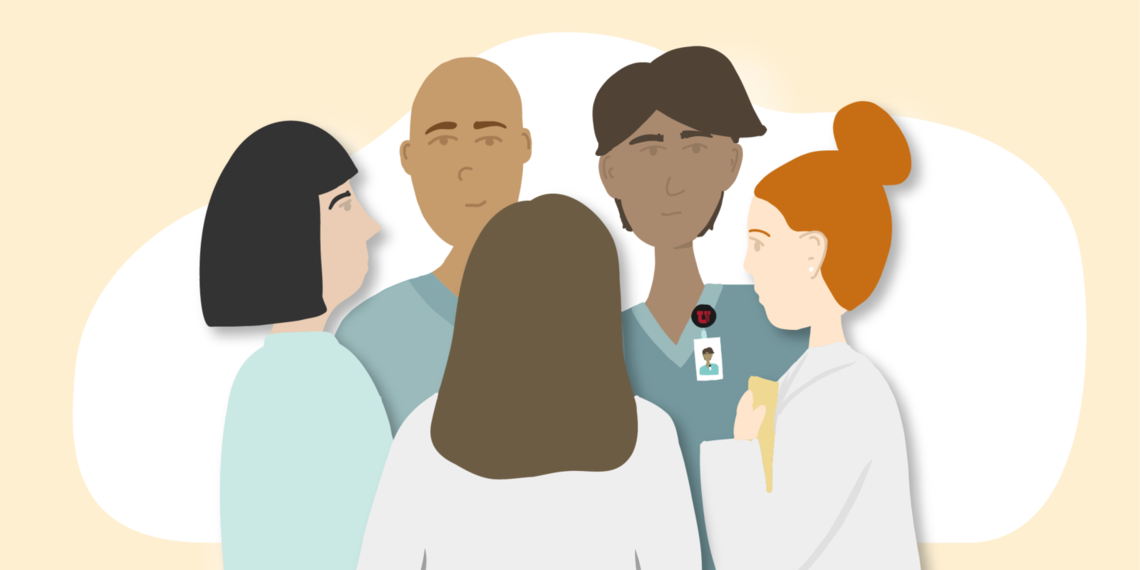Learn by doing

Dr. Cowan leads a one-week Wellness Elective (Monday to Friday) that provides a chance to practice pausing to connect.
ver the years, I’ve spent a great deal of time thinking about how to foster well-being in the workplace. I never imagined that a pandemic would be what hijacked my concentration. As I spiraled into an anxious and exhausted doctor, I resisted the well-being practices I had long espoused and practiced at work. The more I spiraled, the deeper I dug my heels into my refusal to use them.
One thing that has continuously pulled me back is the daily huddle I run the weeks I’m on service with the learners. I have come to see the huddle as a work routine where we get to self-reflect. It also provides a safe space to practice dealing with the types of tension we will encounter caring for patients.
How we huddle for well-being
Every morning before we round, we huddle. While the learners never have to participate, attendance is mandatory. I tell them, “You being here matters because listening is a gift.” We stand up, turn away from our screens and make eye contact. The huddle can be as quick as five or as long as fifteen minutes, it just depends on how much time we have and everyone’s level of engagement.
This is an opportunity for us to hit the pause button. The activities can be corny and range from three fast minutes of calisthenics with someone playing as DJ, several minutes of meditation, reading from a piece of an essay or poem, or a moment of gratitude by sharing one good thing.
How we huddle to practice empathy under tension
After the activity I end the huddle with a powerful question. I address issues and concepts that are current and supposedly off limits. The bombing of a mosque in Christ Church, protests for Black Lives Matter, the January 6th insurrection, the US leaving Afghanistan, homelessness, barriers to transgender care, micro-aggressions, identity and race. I’m not interested in policing the group for ‘wokeness.’ It is about pausing to reflect and being willing to sit in the discomfort. It is an exercise in empathy and compassion toward ourselves as much as it is toward others.
These topics give our huddle meaning and foster community. Real world topics affect how we practice medicine because we don’t stop living in society once we walk into clinic or the wards. We bring all of it with us. These topics also affect our patients, our families and shape our perspectives. They provide a chance for us to figure out who we are that day. I can’t tell you how much bandwidth I have to care for others without taking a minute to self-reflect. The huddle is our opportunity to attach our own oxygen masks before assisting others.
Most importantly the huddle allows us to practice navigating the tension when we don’t all agree. As providers we regularly go into spaces where our patients all don’t share our faith, our values or our skin tone. Sometimes hearing a different perspective from an essay written by a gay man or a Black Muslim woman helps nudge them to check their own privilege or perspective. We begin to see patients and each other as whole people.
Learning to embrace the discomfort
Like any muscle, learning how to build healthy boundaries takes time and dedication. As faculty, I coach boundary setting with the trainees during our daily huddles. I’ve invested time developing practices that support all of our well-being.
Part of workplace wellness is setting clear boundaries that communicate our limits. For example, once when discussing racism during a huddle, the room began to feel particularly polarized. Instead of retreating, I asked the group to pause and take a collective breath. I pointed out how talking about race and racism is tense for everyone no matter their skin tone. Could we stretch ourselves and think about how might our lives been different had we been born into a different racial group?
The huddle isn’t going to fix systemic racism, it provides time for reflection often missing in medicine. Realizing what I don’t know, finding a blind spot, getting curious about why I react so strongly or care so deeply, this is the purpose.
When boundaries break down
A lot of us in health care are conflicted now. We chose this career to help people, but the controversial nature of the pandemic has left us questioning whether we can continue working under such strenuous conditions, and with patients who openly defy or insult us. Some days I wonder—how can some people not believe in science, the data, evidence and truth? And yet, some of those people are my patients and family. When I feel like I’m in the Twilight Zone, that’s when I have to ground myself. Sharing a laugh in the team room, venting to a colleague, walking the stairwell all seem to help.
If I am going to cultivate kindness, I have to be willing to sit with the differences many in our country have from me. What I wonder is—even if we all don’t agree, can we come together and support each other? Can we suspend our judgements and beliefs to align our values and look out for our community and country? Perhaps it’s a lot more interesting when we all don’t share the same opinion. What I wonder lately is—how do we make space for the mess? If I want more kindness, I have to bring it and demand it. I’m working on finding my agency through modeling, expecting and appreciating a safe, respectful work environment.
Acknowledgement: Editorial assistance provided by Kim Mahoney and Mari Ransco.
Amy Cowan
Chief Wellness Officer Amy Locke shares practical strategies for leaders to address the real tension we’re feeling between the desire to take a break and the increasing workload.
Coworkers are often the first to recognize when a peer is struggling under extreme stress. Psychiatrist Kristin Francis and psychologist Rob Davies share how to break through the discomfort and talk to your struggling colleague.
Well-being specialist Trinh Mai started BIPOC (Black, Indigenous, People of color) Check-in & Support via Zoom as a place to grieve and honor George Floyd and process ongoing racism. This is a space for employees at the U who self-identify as BIPOC to experience community, share struggles and solutions, and celebrate being who they are. Trinh and some members of the check in group share how the group started, how it has evolved and its lasting impacts.
